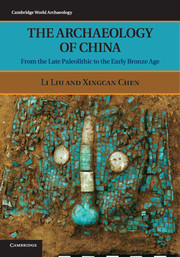Book contents
- Frontmatter
- Contents
- Illustrations
- Tables
- Preface
- Chapter 1 Chinese archaeology: Past, present, and future
- Chapter 2 Environment and ecology
- Chapter 3 Foragers and collectors in the Pleistocene-Holocene transition (24,000–9000 cal. BP)
- Chapter 4 Domestication of plants and animals
- Chapter 5 Neolithization: Sedentism and food production in the early Neolithic (7000–5000 BC)
- Chapter 6 Emergence of social inequality – The middle Neolithic (5000–3000 BC)
- Chapter 7 Rise and fall of early complex societies: The late neolithic (3000–2000 BC)
- Chapter 8 Formation of early states in the Central Plain: Erlitou and Erligang (1900/1800–1250 BC)
- Chapter 9 Bronze cultures of the northern frontiers and beyond during the early second millennium BC
- Chapter 10 The late shang dynasty and its neighbors (1250–1046 BC)
- Chapter 11 Chinese civilization in comparative perspective
- Appendix Horse bones in faunal assemblages from Neolithic and early Bronze Age sites in north China
- Glossary
- References
- Index
Chapter 4 - Domestication of plants and animals
Published online by Cambridge University Press: 05 June 2012
- Frontmatter
- Contents
- Illustrations
- Tables
- Preface
- Chapter 1 Chinese archaeology: Past, present, and future
- Chapter 2 Environment and ecology
- Chapter 3 Foragers and collectors in the Pleistocene-Holocene transition (24,000–9000 cal. BP)
- Chapter 4 Domestication of plants and animals
- Chapter 5 Neolithization: Sedentism and food production in the early Neolithic (7000–5000 BC)
- Chapter 6 Emergence of social inequality – The middle Neolithic (5000–3000 BC)
- Chapter 7 Rise and fall of early complex societies: The late neolithic (3000–2000 BC)
- Chapter 8 Formation of early states in the Central Plain: Erlitou and Erligang (1900/1800–1250 BC)
- Chapter 9 Bronze cultures of the northern frontiers and beyond during the early second millennium BC
- Chapter 10 The late shang dynasty and its neighbors (1250–1046 BC)
- Chapter 11 Chinese civilization in comparative perspective
- Appendix Horse bones in faunal assemblages from Neolithic and early Bronze Age sites in north China
- Glossary
- References
- Index
Summary
To the rulers people are the most important, and to people food is the most important.
Chapter “Li Yiji Biography” in Hanshu, by Ban Gu (AD 32–92) (Ban, 1962: 2108)“王者以民为天, 而民以食为天。” 《汉书 · 郦食其传》 班固
China is one of the few primary loci of plant and animal domestication and of emergent agriculture in the world (Bellwood 2005; Smith 1998). Chinese society has been predominantly agrarian since antiquity, and, as in other parts of the world, agriculture formed the economic foundation for the rise of civilization in China. Among the most important crops and animals known in early China (rice, millet, soybean, pigs, dogs, and perhaps chickens) were domesticated indigenously, whereas wheat, barley, sheep, goats, and horses were introduced, already domesticated, from elsewhere. The origins of domesticated cattle and water buffalo are unclear at present; these species were surely domesticated separately in time and place, but exactly where and when those transformations occurred remain moot. Unlike other chapters in this book that present archaeological information in a temporospatial order, in this chapter, we focus on the domestication of each species just mentioned. The purpose of this arrangement is to provide a database for easy discussion in the following chapters.
- Type
- Chapter
- Information
- The Archaeology of ChinaFrom the Late Paleolithic to the Early Bronze Age, pp. 75 - 122Publisher: Cambridge University PressPrint publication year: 2012
- 3
- Cited by

